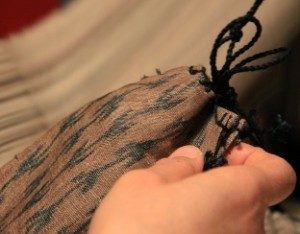
Fujino is both, remote as much as easily accessible: Located 20 train minutes west of the popular tourist area of Mount Takao, it takes just over an hour to or from down town Tokyo.
A firm part of Fujino are also a number of hamlets. They are scattered and perched on hillsides, with rice fields between them, and tea fields as their direct neighbours. In those hamlets, there remain still a good number of old traditional Japanese houses, which however are far less cherished than the newly built structures, and certainly less than the tea or rice fields.
At one time, in a not too distant past, one of the main income sources for the locals in the area were silk cocoons: the fields were as often as not the homes to abundant numbers of Mulberry trees. Their leaves would be fed to the silk worms, whose cocoons then would be sold to silk manufacturers.
In the silk breeding heydays, the local textile silk knowledge was abundant: cocoons with imperfections would not normally be accepted by the manufacturers, and hence people learned how to reel silk and weave fabrics from ‘imperfect’ cocoons. Needless to say that precisely the thread’s imperfections was the root to a rarely found beauty in the fabrics.
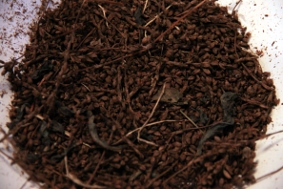
But where there is silk, other materials – among them Asa, a Japanese hemp variety -, dye stuffs, and dye techniques are never far.
And it is precisely the combination of all these skills that has brought me to this corner of the greater Tokyo area: Fujino is, and has been for over 2 decades, the home of Bryan Whitehead, and expert in a wide range of Japanese textile crafts.
Bryan is in the present one of the few persons who has become an expert not only in how to make his own silk from start to finish, but also how to grow Indigo, and in all things natural dyes and dye techniques.
When Bryan moved to Fujino, a couple of families still bred their own silk. By now, he is the only remaining silk breeder in the area. Voluntarily or not, he is in fact the heir to the local textile heritage. Partially self-thought, and partially educated as the disciple of long-seasoned artisan, a women who at the time was about to retire due to old age, his knowledge is – atypical for the Japanese craftsmanship traditions – as broad as it is deep and encompasses all aspects of hand-made textiles.
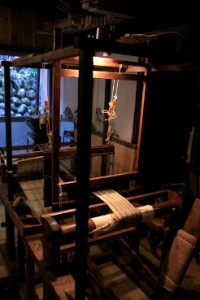
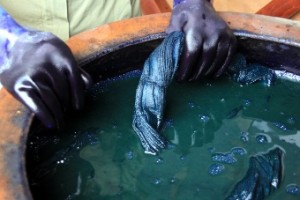
Bryan’s multifunctional old style Japanese 3.5 story home serves as dye studio, weaving shed, and – important! – class room. Visitors are greeted first thing by a rather large vat full of Indigo, ready for dyeing. Textile craftsmanship seeps from every corner and angle of the house.
When I visited the artist, the house was brimming with students and locals for an end-of-year get together. One student was working on a stencil indigo dye piece, another one tried her hand on tie dyeing a table cloth, two students where in the process of weaving, and yen another one had copied a drawing onto a cloth, and was preparing for it to be dyed later on. Questions were many, as were the instructions that needed being given out. Ripped warp threads here, weaving errors there, and questions about dye timings at the other end.
It becomes clear that the artist cherishes his students in a way that only those do that themselves enjoyed the good luck of finding inspiring, dedicated teachers: No question too simple not to merit an answer, no mistake too basic not to merit a serious explanation and a useful hint on how to to better next time. Patience, dedication, thoroughness and passion – a package for which some of the students taken upon themselves a return journey of 4 hours or more.
Given the current state of affairs, the dedication of skilled craftsmen and women as teachers may well decide the fate of those textile crafts at the verge of extinction. And the reality is that there are not as many dedicated and proud teachers as there are – potentially – interested students.
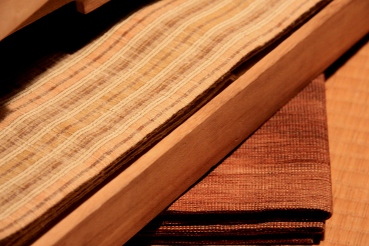
In Europe at least, an often heard quote goes as follows: 'those who can, do; those who can't, teach'.
The meaning, of course, being that not the most skilled end up as teachers, but rather those that don’t make the cut for the top proceed into teaching. More often than not, a seasoned professional aims at being able to reap the rewards of their skills and effort through product sales, exhibitions etc. Having to teach equals with having failed professional and as a craftsman/women.
The Asian tradition is, however, substantially different in that only the best can pride themselves of being a ‘sensei’, i.e. a teacher apt to guide the students along the way of acquiring a skill, a craft and – at some point – a profession. Teaching as much as being taught is – from a traditional perspective at least – a gift, a privilege.
Of course this doesn’t remedy the lack of interested in terms of total numbers, but there is equally no doubt that traditional craftsmanship is much more alive, and appreciated, in this part of the world than in most Western countries.
—
Bryan Whitehead’s Japanese Textile Workshop is well documented in his blog.
Starting in Spring 2012, periodically textile study tours will take place. The focus will be on hands on experience with Indigo dyeing and silk making, yet without forgetting about exploring the local area.

